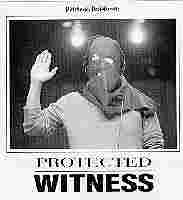

So when several protected witnesses complained to a Post-Gazette reporter that the program had run amok, ordinary research techniques did not suffice.
Nine written requests for information about the program were made to the U.S. Justice Department, citing the Federal Freedom of Information Act which gives the public access to records of government activity.
Sixteen months later, none of the documents has been released other than a copy of one audit done by the U.S. General Accounting Office. Almost half of that was blanked out for "national security" reasons.
In addition, the protected witnesses who were talking to the reporter would not give their names, saying they feared retaliation from officials who did not want information made public. Eventually the reporter found George E. Taylor Jr., a protected witness in prison who had become so angered by the program that he sent letters to Congressmen and other federal officials asking for an investigation.
Taylor said his letters were forwarded, in turn, to Witness Security officials who threatened to banish him from the program if he didn't stop talking.
Taylor continued to talk. In trying to set up an interview with the Post-Gazette reporter, Taylor relied on a confidential Memorandum of Understanding every protected witness signs before going into the program. It states that members of the program have the right to "correspond with members of the news media in accordance with Bureau rules and institution guidelines."
After Taylor agreed to be interviewed, the reporter followed regular U.S. Bureau of Prison procedures and made his interview request in a letter to Taylor.
It was four months before that letter and several others made their way to Taylor.
Then after several more months of inactivity, the Office of Enforcement Operations, the Justice Department entity that runs the witness program, met with Taylor and restricted what he would be allowed to discuss with the Post-Gazette.
"I couldn't talk about anything, including the weather because they said that might give someone an idea of where I was at. I was told what I could say and what I couldn't say and threatened that if I said anything else, they were going to stop the interview and put me into the hole [disciplinary custody]," Taylor said.
Even so, the meeting didn't occur while he was imprisoned. The two finally met in June 1995 when Taylor was paroled and removed from the program.
While he was waiting for Taylor's release, the reporter searched data bases and court records and interviewed scores of federal and state prosecutors throughout America in efforts to interview as many members of the program as possible.
Eventually, he sent more than 2,000 letters to protected witnesses, their families, friends, prison staff members, lawyers, prosecutors and others who had contact with the protected witnesses.
The letters explained his investigation of the witness program and requested anyone with evidence about it to come forward.
To ensure no breach of security would occur, the reporter sent most of the letters to a Justice Department "mail drop" in Washington. Under the rules of the program's contract with witnesses, the mail drop was set up "to ensure the confidentiality of your location and identity as a protected witness." While almost every one of the protected witnesses had not only been identified in court records, but typically were cross-examined publicly on the witness stand about their cooperation deals, the Justice Department refused to confirm they were in the program.
Further, about 100 letters sent directly to protected witnesses were intercepted by the Justice Department since "Forwarding your letters would be an implicit confirmation of the individual's participation, and might further suggest to the individuals who receive your letter that there has been a breach of security," a Justice Department letter said.
At the same time, the reporter sent letters to individuals with the same last names of protected witnesses in their home communities. He also contacted victims of their crimes.
The combined efforts resulted in interviews with 24 protected witnesses and dozens of prison staff, parole authorities, lawyers, victims and others in 12 states.
Because most of the protected witnesses refused to talk for the record, the reporter relied on court records and multiple interviews with people involved in the program to confirm the information in these reports.
-- Bill Moushey